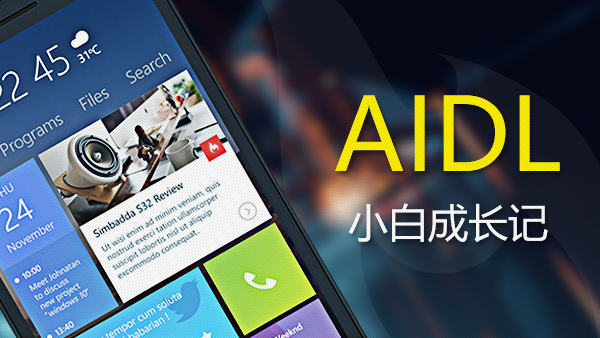v7包下的组件类似CoordinatorLayout推出也有一段时间了,大家使用的时候应该会体会到其中很多的便利,今天这篇文章带大家来了解一个比较重要的ui组件——Behavior。从字面意思上就可以看出它的作用,就是用来规定某些组件的行为的,那它到底是什么,又该怎么用呢?看完这篇文章希望大家会有自己的收获~
前言
写这篇文章的起因是因为我无意中在GitHub上发现了Jake Wharton大神新建了一个Repo,内容是JakeWharton/DrawerBehavior。有兴趣的同学可以去看看,其实就是通过Behavior去构造一个类似于DrawerLayout的布局。想了想已经挺长时间没有搞ui方面的代码了,所以趁着这个机会复习了一下,顺便写一篇文章巩固,也给想要了解这方面内容的同学一个平台吧。
Behavior是什么
在文章的开始,我们先要了解什么是Behavior。
1 | /**
* Interaction behavior plugin for child views of {@link CoordinatorLayout}.
*
* <p>A Behavior implements one or more interactions that a user can take on a child view.
* These interactions may include drags, swipes, flings, or any other gestures.</p>
*
* @param <V> The View type that this Behavior operates on
*/
public static abstract class < extends > {
...........
public boolean (CoordinatorLayout parent, V child, MotionEvent ev) {
return false;
}
public boolean (CoordinatorLayout parent, V child, int layoutDirection) {
return false;
}
...........
} |
它是CoordinatorLayout的内部类,从它的注释和其中的方法可以看出来,它其实就是给CoordinatorLayout的子View提供了一些交互的方法,用来规范它们的交互行为,比如上面出现的onTouchEvent可以用来规范子View的触摸事件,onLayoutChild可以用来规范子View的布局。
说到这里,大家可能会有一个问题,CoordinatorLayout又是个什么东西?
1 | public class extends implements {
} |
可以看出,它其实就是一个ViewGroup,实现了NestedScrollingParent用来执行嵌套滑动。至于嵌套滑动的机制大家可以看我博客的第一篇文章,这不是我们这篇文章的重点。
既然CoordinatorLayout仅仅只是一个ViewGroup,它又为什么能展示出它在xml布局中展示的威力呢?其中的秘密就是在Behavior中。我们可以这么说,CoordinatorLayout利用了Behavior作为一个代理,去控制管理其下的子View做到各种布局和动画效果。那为什么要使用Behavior呢?我想原因大概就是解耦吧,如果把所有的逻辑都写死在CoordinatorLayout中,一来不利于维护,二来我们就没有做一些自定义的事情,会显得非常的笨重。
为什么要用Behavior
这里我们举一个非常简单的例子。首先来看看我们的布局文件。
1 | <?xml version="1.0" encoding="utf-8"?> <android.support.design.widget.CoordinatorLayout xmlns:android="http://schemas.android.com/apk/res/android" xmlns:app="http://schemas.android.com/apk/res-auto" android:id="@+id/main_fragment_container" android:layout_width="match_parent" android:layout_height="match_parent"> <android.support.design.widget.AppBarLayout android:id="@+id/app_bar" android:layout_width="match_parent" android:layout_height="48dp"> <TextView android:background="#ff0000" android:layout_width="match_parent" android:layout_height="match_parent" android:text="title" android:textColor="#00ff00" android:gravity="center"/> </android.support.design.widget.AppBarLayout> <android.support.v7.widget.RecyclerView android:id="@+id/list" android:layout_width="match_parent" android:layout_height="match_parent" app:layout_behavior="@string/appbar_scrolling_view_behavior"> </android.support.v7.widget.RecyclerView> </android.support.design.widget.CoordinatorLayout> |
非常简单有木有,CoordinatorLayout作为根布局,里面一个AppBarLayout一个RecyclerView。让我们看看界面是怎么样的。

可以看到显示是正确的。但是如果我把xml里RecyclerView的那行layout_behavior删掉呢?就像这样。
1 | <?xml version="1.0" encoding="utf-8"?> <android.support.design.widget.CoordinatorLayout xmlns:android="http://schemas.android.com/apk/res/android" xmlns:app="http://schemas.android.com/apk/res-auto" android:id="@+id/main_fragment_container" android:layout_width="match_parent" android:layout_height="match_parent"> <android.support.design.widget.AppBarLayout android:id="@+id/app_bar" android:layout_width="match_parent" android:layout_height="48dp"> <TextView android:background="#ff0000" android:layout_width="match_parent" android:layout_height="match_parent" android:text="title" android:textColor="#00ff00" android:gravity="center"/> </android.support.design.widget.AppBarLayout> <android.support.v7.widget.RecyclerView android:id="@+id/list" android:layout_width="match_parent" android:layout_height="match_parent"> </android.support.v7.widget.RecyclerView> </android.support.design.widget.CoordinatorLayout> |

最终界面的展示就像这样,RecyclerView把AppBarLayout给覆盖了。这里其实很好理解,如刚才的代码所示,CoordinatorLayout其实只是一个ViewGroup,它不像LinearLayout那样具有特定的布局特点,甚至可以说它内部的逻辑和FrameLayout是没什么差别的,所以如果你不设置对应的Behavior的话,布局就会有问题。从这里也可以反映出Behavior的作用,就是规范子View的显示和交互。
原理&系统是怎么用Behavior的
说完了Behavior的作用,那该怎么用它呢?这一小节让我们来讲讲Behavior的原理以及系统是如何使用它的。
首先先看原理。我们知道Behavior是用来帮助CoordinatorLayout的,所以我们要从CoordinatorLayout中寻找答案。首先,我们可以看到CoordinatorLayout中有一个LayoutParams,它的子View的LayoutParams都是这个,其中它的构造函数如下。
1 | LayoutParams(Context context, AttributeSet attrs) {
super(context, attrs);
.........
if (mBehaviorResolved) {
mBehavior = parseBehavior(context, attrs, a.getString(
R.styleable.CoordinatorLayout_LayoutParams_layout_behavior));
}
a.recycle();
} |
可以看到它通过parseBehavior去得到了对应子View的Behavior。大家可以试试用RecyclerView的getLayoutParams方法去获取LayoutParams并且调用getBehavior方法,可以得到的就是我们在xml文件中设置的那个Behavior。
知道了如何将Behavior设置进去,那它是如何发挥作用的呢?让我们来看看onLayout函数。
1 | @Override
protected void (boolean changed, int l, int t, int r, int b) {
final int layoutDirection = ViewCompat.getLayoutDirection(this);
final int childCount = mDependencySortedChildren.size();
for (int i = 0; i < childCount; i++) {
final View child = mDependencySortedChildren.get(i);
final LayoutParams lp = (LayoutParams) child.getLayoutParams();
final Behavior behavior = lp.getBehavior();
if (behavior == null || !behavior.onLayoutChild(this, child, layoutDirection)) {
onLayoutChild(child, layoutDirection);
}
}
} |
可以看到的是其中会先调用behavior.onLayoutChild(this, child, layoutDirection)。也就是说,Behavior的逻辑要优先于CoordinatorLayout自己的逻辑。其实不止是onLayout,我们还可以看看onTouchEvent这个函数。
1 | public boolean (MotionEvent ev) {
boolean handled = false;
boolean cancelSuper = false;
MotionEvent cancelEvent = null;
final int action = MotionEventCompat.getActionMasked(ev);
if (mBehaviorTouchView != null || (cancelSuper = performIntercept(ev, TYPE_ON_TOUCH))) {
// Safe since performIntercept guarantees that
// mBehaviorTouchView != null if it returns true
final LayoutParams lp = (LayoutParams) mBehaviorTouchView.getLayoutParams();
final Behavior b = lp.getBehavior();
if (b != null) {
handled = b.onTouchEvent(this, mBehaviorTouchView, ev);
}
}
.........
return handled;
} |
可以看到也是调用了Behavior的onTouchEvent,我们可以下判断说Behavior中的那些方法在CoordinatorLayout中都会在合适的时机去调用。这也证明了我们刚才的那句话:[Behavior就是CoordinatorLayout的代理,帮助它去管理子View]。
我们做一个总结,Behavior可以代理哪些行为呢?
1.Measure和Layout的布局行为。
2.onTouchEvent和onInterceptTouchEvent的触摸行为。比如design包中的SwipeDismissBehavior就是通过这样的方式完成的。
3.嵌套滑动行为(NestedScrollingParent和NestedScrollingChild中的逻辑)。
4.子View间的依赖行为。
对于第四点我们这里可以细说一下,什么叫子View的依赖行为呢?这里我们举个例子,我们都知道如果在CoordinatorLayout中使用了FAB并且点击展示SnackbarLayout的话,FAB会在Snackbar显示的时候对应的上移,这是因为FAB依赖了SnackbarLayout。
1 | public static class extends .<> {
........
@Override
public boolean (CoordinatorLayout parent,
FloatingActionButton child, View dependency) {
// We're dependent on all SnackbarLayouts (if enabled)
return SNACKBAR_BEHAVIOR_ENABLED && dependency instanceof Snackbar.SnackbarLayout;
}
@Override
public boolean (CoordinatorLayout parent, FloatingActionButton child,View dependency) {
if (dependency instanceof Snackbar.SnackbarLayout) {
updateFabTranslationForSnackbar(parent, child, dependency);
} else if (dependency instanceof AppBarLayout) {
// If we're depending on an AppBarLayout we will show/hide it automatically
// if the FAB is anchored to the AppBarLayout
updateFabVisibility(parent, (AppBarLayout) dependency, child);
}
return false;
}
........
} |
这是FAB中的Behavior,可以看到它重写了layoutDependsOn和onDependentViewChanged,里面的逻辑很简单的就可以看明白。这里我们[将代码翻译成语言]就是说FAB要依赖的组件是SnackbarLayout,所以在之后的操作里当DependentView(SnackbarLayout)发生了改变,自己(FAB)也会相应的做出改变。
值得一提的是,onDependentViewChanged这个函数的调用时机并不是在onLayout之前,而是在onPreDraw中,具体代码如下:
1 | class implements . {
@Override
public boolean () {
dispatchOnDependentViewChanged(false);
return true;
}
} |
如此简单的处理View间的依赖,可见Behavior配合CoordinatorLayout是有多强大。下面我们可以再举一个例子来讲讲Behavior的作用。还记得我们上面说的吗?RecyclerView设置了一个Behavior它就可以和AppBarLayout很好的展示出来。这个Behavior的名字是:
1 | app:layout_behavior="@string/appbar_scrolling_view_behavior" <string name="appbar_scrolling_view_behavior" translatable="false">android.support.design.widget.AppBarLayout$ScrollingViewBehavior</string> |
可以看到它是AppBarLayout里的一个内部类,让我们看看它做了什么。
1 | @Override
public boolean (CoordinatorLayout parent, View child, View dependency) {
// We depend on any AppBarLayouts
return dependency instanceof AppBarLayout;
}
@Override
public boolean (CoordinatorLayout parent, View child,
View dependency) {
offsetChildAsNeeded(parent, child, dependency);
return false;
}
private void (CoordinatorLayout parent, View child, View dependency) {
final CoordinatorLayout.Behavior behavior =
((CoordinatorLayout.LayoutParams) dependency.getLayoutParams()).getBehavior();
if (behavior instanceof Behavior) {
// Offset the child, pinning it to the bottom the header-dependency, maintaining
// any vertical gap, and overlap
final Behavior ablBehavior = (Behavior) behavior;
final int offset = ablBehavior.getTopBottomOffsetForScrollingSibling();
child.offsetTopAndBottom((dependency.getBottom() - child.getTop())
+ ablBehavior.mOffsetDelta
+ getVerticalLayoutGap()
- getOverlapPixelsForOffset(dependency));
}
} |
我们知道,如果不设置这个Behavior的话,RecyclerView会覆盖AppBarLayout。而上面这段代码里的逻辑就可以很好的解释这个原因了。值得一提的是,在offsetChildAsNeeded方法中有这么一段:
1 | final CoordinatorLayout.Behavior behavior = ((CoordinatorLayout.LayoutParams) dependency.getLayoutParams()).getBehavior();
if (behavior instanceof Behavior) {
// Offset the child, pinning it to the bottom the header-dependency, maintaining
// any vertical gap, and overlap
final Behavior ablBehavior = (Behavior) behavior; |
这里dependency就是AppBarLayout,所以我们可以知道,AppBarLayout中有两个Behavior,一个是我们前面提到的ScrollingViewBehavior,用来处理它和其他滑动View的关系,另外一个就是Behavior,用来处理自己的逻辑,比如Layout。通过这种巧妙的方式,我们就可以做到非常简便的控制View本身和View之间的逻辑。
如何自定义Behavior
本来想写个demo给大家看一看的,不过感觉还是不要重复造轮子了,还是没用的轮子。推荐大家看SwipeDismissBehavior用法及实现原理这篇文章和一开始提到的Jake大神的新作DrawerBehavior。如果你把这两个东西搞懂,那么Behavior你可以说已经完全没问题了~
后记
最近一段时间都在搞hotPatch和插件化相关的东西,看了很多Framework层的源码,要做的东西也做的七七八八,希望快点解决最后的几个bug并且之后能开源和大家见面吧~

 随时随地看视频
随时随地看视频




